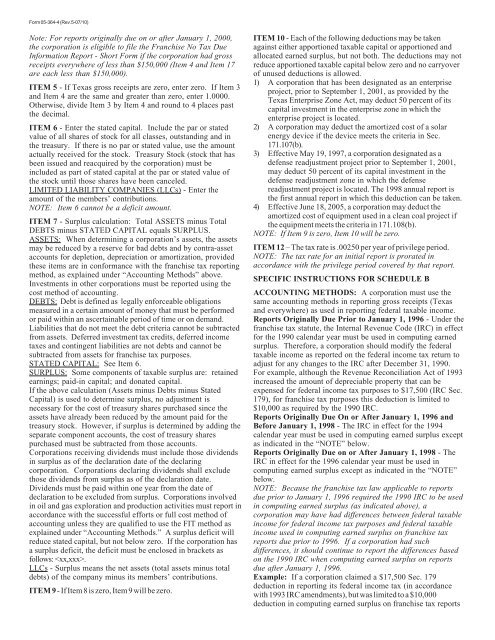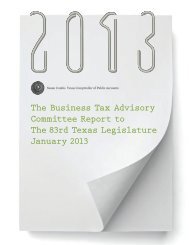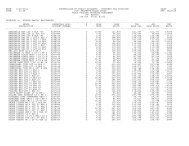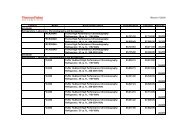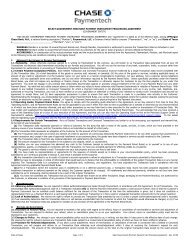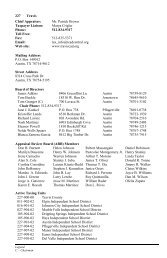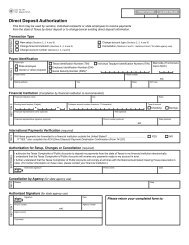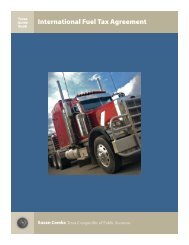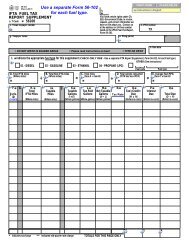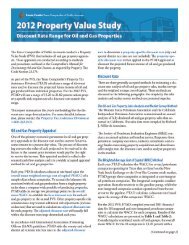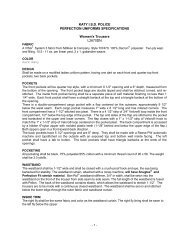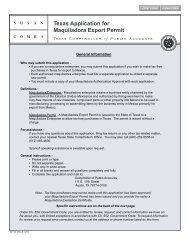Instructions for completing franchise tax reports originally due
Instructions for completing franchise tax reports originally due
Instructions for completing franchise tax reports originally due
Create successful ePaper yourself
Turn your PDF publications into a flip-book with our unique Google optimized e-Paper software.
Form 05-364-4 (Rev.5-07/10)Note: For <strong>reports</strong> <strong>originally</strong> <strong>due</strong> on or after January 1, 2000,the corporation is eligible to file the Franchise No Tax DueIn<strong>for</strong>mation Report - Short Form if the corporation had grossreceipts everywhere of less than $150,000 (Item 4 and Item 17are each less than $150,000).ITEM 5 - If Texas gross receipts are zero, enter zero. If Item 3and Item 4 are the same and greater than zero, enter 1.0000.Otherwise, divide Item 3 by Item 4 and round to 4 places pastthe decimal.ITEM 6 - Enter the stated capital. Include the par or statedvalue of all shares of stock <strong>for</strong> all classes, outstanding and inthe treasury. If there is no par or stated value, use the amountactually received <strong>for</strong> the stock. Treasury Stock (stock that hasbeen issued and reacquired by the corporation) must beincluded as part of stated capital at the par or stated value ofthe stock until those shares have been canceled.LIMITED LIABILITY COMPANIES (LLCs) - Enter theamount of the members’ contributions.NOTE: Item 6 cannot be a deficit amount.ITEM 7 - Surplus calculation: Total ASSETS minus TotalDEBTS minus STATED CAPITAL equals SURPLUS.ASSETS: When determining a corporation’s assets, the assetsmay be reduced by a reserve <strong>for</strong> bad debts and by contra-assetaccounts <strong>for</strong> depletion, depreciation or amortization, providedthese items are in con<strong>for</strong>mance with the <strong>franchise</strong> <strong>tax</strong> reportingmethod, as explained under “Accounting Methods” above.Investments in other corporations must be reported using thecost method of accounting.DEBTS: Debt is defined as legally en<strong>for</strong>ceable obligationsmeasured in a certain amount of money that must be per<strong>for</strong>medor paid within an ascertainable period of time or on demand.Liabilities that do not meet the debt criteria cannot be subtractedfrom assets. Deferred investment <strong>tax</strong> credits, deferred income<strong>tax</strong>es and contingent liabilities are not debts and cannot besubtracted from assets <strong>for</strong> <strong>franchise</strong> <strong>tax</strong> purposes.STATED CAPITAL: See Item 6.SURPLUS: Some components of <strong>tax</strong>able surplus are: retainedearnings; paid-in capital; and donated capital.If the above calculation (Assets minus Debts minus StatedCapital) is used to determine surplus, no adjustment isnecessary <strong>for</strong> the cost of treasury shares purchased since theassets have already been reduced by the amount paid <strong>for</strong> thetreasury stock. However, if surplus is determined by adding theseparate component accounts, the cost of treasury sharespurchased must be subtracted from those accounts.Corporations receiving dividends must include those dividendsin surplus as of the declaration date of the declaringcorporation. Corporations declaring dividends shall excludethose dividends from surplus as of the declaration date.Dividends must be paid within one year from the date ofdeclaration to be excluded from surplus. Corporations involvedin oil and gas exploration and production activities must report inaccordance with the successful ef<strong>for</strong>ts or full cost method ofaccounting unless they are qualified to use the FIT method asexplained under “Accounting Methods.” A surplus deficit willreduce stated capital, but not below zero. If the corporation hasa surplus deficit, the deficit must be enclosed in brackets asfollows: .LLCs - Surplus means the net assets (total assets minus totaldebts) of the company minus its members’ contributions.ITEM 9 - If Item 8 is zero, Item 9 will be zero.ITEM 10 - Each of the following deductions may be takenagainst either apportioned <strong>tax</strong>able capital or apportioned andallocated earned surplus, but not both. The deductions may notreduce apportioned <strong>tax</strong>able capital below zero and no carryoverof unused deductions is allowed.1) A corporation that has been designated as an enterpriseproject, prior to September 1, 2001, as provided by theTexas Enterprise Zone Act, may deduct 50 percent of itscapital investment in the enterprise zone in which theenterprise project is located.2) A corporation may deduct the amortized cost of a solarenergy device if the device meets the criteria in Sec.171.107(b).3) Effective May 19, 1997, a corporation designated as adefense readjustment project prior to September 1, 2001,may deduct 50 percent of its capital investment in thedefense readjustment zone in which the defensereadjustment project is located. The 1998 annual report isthe first annual report in which this deduction can be taken.4) Effective June 18, 2005, a corporation may deduct theamortized cost of equipment used in a clean coal project ifthe equipment meets the criteria in 171.108(b).NOTE: If Item 9 is zero, Item 10 will be zero.ITEM 12 – The <strong>tax</strong> rate is .00250 per year of privilege period.NOTE: The <strong>tax</strong> rate <strong>for</strong> an initial report is prorated inaccordance with the privilege period covered by that report.SPECIFIC INSTRUCTIONS FOR SCHEDULE BACCOUNTING METHODS: A corporation must use thesame accounting methods in reporting gross receipts (Texasand everywhere) as used in reporting federal <strong>tax</strong>able income.Reports Originally Due Prior to January 1, 1996 - Under the<strong>franchise</strong> <strong>tax</strong> statute, the Internal Revenue Code (IRC) in effect<strong>for</strong> the 1990 calendar year must be used in computing earnedsurplus. There<strong>for</strong>e, a corporation should modify the federal<strong>tax</strong>able income as reported on the federal income <strong>tax</strong> return toadjust <strong>for</strong> any changes to the IRC after December 31, 1990.For example, although the Revenue Reconciliation Act of 1993increased the amount of depreciable property that can beexpensed <strong>for</strong> federal income <strong>tax</strong> purposes to $17,500 (IRC Sec.179), <strong>for</strong> <strong>franchise</strong> <strong>tax</strong> purposes this deduction is limited to$10,000 as required by the 1990 IRC.Reports Originally Due On or After January 1, 1996 andBe<strong>for</strong>e January 1, 1998 - The IRC in effect <strong>for</strong> the 1994calendar year must be used in computing earned surplus exceptas indicated in the “NOTE” below.Reports Originally Due on or After January 1, 1998 - TheIRC in effect <strong>for</strong> the 1996 calendar year must be used incomputing earned surplus except as indicated in the “NOTE”below.NOTE: Because the <strong>franchise</strong> <strong>tax</strong> law applicable to <strong>reports</strong><strong>due</strong> prior to January 1, 1996 required the 1990 IRC to be usedin computing earned surplus (as indicated above), acorporation may have had differences between federal <strong>tax</strong>ableincome <strong>for</strong> federal income <strong>tax</strong> purposes and federal <strong>tax</strong>ableincome used in computing earned surplus on <strong>franchise</strong> <strong>tax</strong><strong>reports</strong> <strong>due</strong> prior to 1996. If a corporation had suchdifferences, it should continue to report the differences basedon the 1990 IRC when computing earned surplus on <strong>reports</strong><strong>due</strong> after January 1, 1996.Example: If a corporation claimed a $17,500 Sec. 179deduction in reporting its federal income <strong>tax</strong> (in accordancewith 1993 IRC amendments), but was limited to a $10,000deduction in computing earned surplus on <strong>franchise</strong> <strong>tax</strong> <strong>reports</strong>


